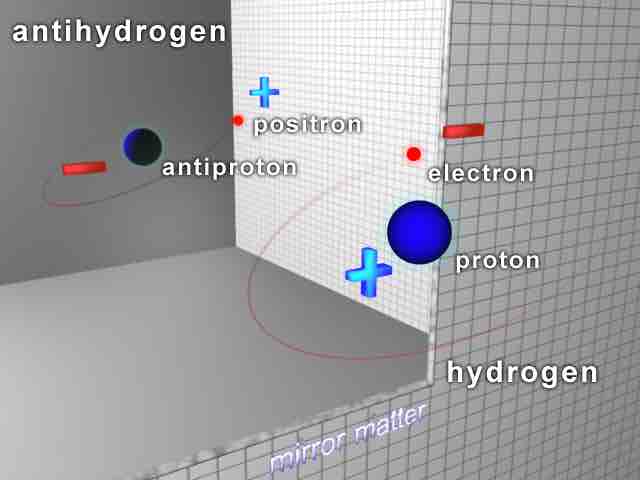Antimatter is material composed of antiparticles, which have the same mass as particles of ordinary matter but have opposite charge and quantum spin. Antiparticles bind with each other to form antimatter in the same way that normal particles bind to form normal matter. For example, a positron (the antiparticle of the electron, with symbol e+) and an antiproton (symbol p-) can form an antihydrogen atom . Furthermore, mixing matter and antimatter can lead to the annihilation of both, in the same way that mixing antiparticles and particles does. This gives rise to high-energy photons (gamma rays) and other particle-antiparticle pairs. The end result of antimatter meeting matter is a release of energy proportional to the mass, as shown in the mass-energy equivalence equation, E = mc2.

Antihydrogen and Hydrogen Atoms
Antihydrogen consists of an antiproton and a positron; hydrogen consists of a proton and an electron.
Almost all matter observable from the earth seems to be made of matter rather than antimatter. If antimatter-dominated regions of space existed, the gamma rays produced in annihilation reactions along the boundary between matter and antimatter regions would be detectable.
Antimatter may still exist in relatively large amounts in far-away galaxies due to cosmic inflation in the primordial time of the universe. Antimatter galaxies, if they exist, are expected to have the same chemistry and absorption and emission spectra as normal-matter galaxies, and their astronomical objects would be observationally identical, making them difficult to distinguish from normal-matter galaxies.
There is considerable speculation as to why the observable universe is apparently composed almost entirely of matter (as opposed to a mixture of matter and antimatter), whether there exist other places that are almost entirely composed of antimatter instead, and what sorts of technology might be possible if antimatter could be harnessed. At this time, the apparent asymmetry of matter and antimatter in the visible universe is one of the greatest unsolved problems in physics.